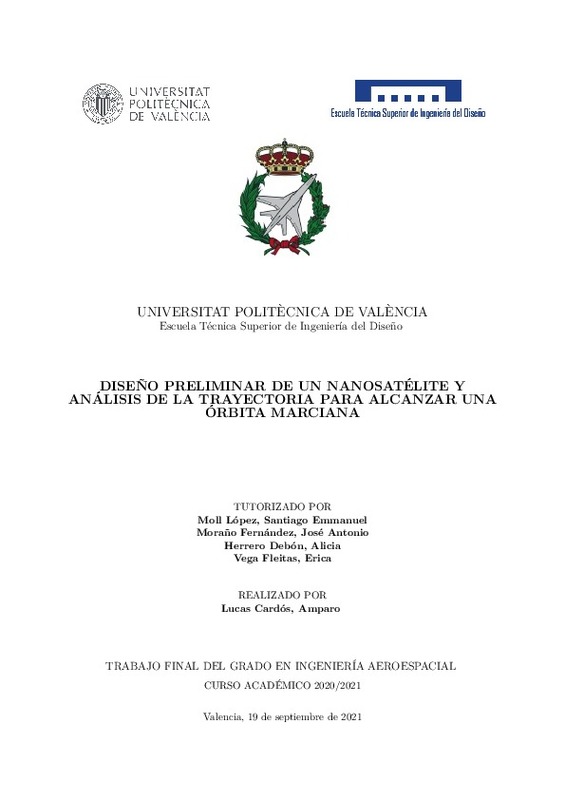JavaScript is disabled for your browser. Some features of this site may not work without it.
Buscar en RiuNet
Listar
Mi cuenta
Estadísticas
Ayuda RiuNet
Admin. UPV
Diseño preliminar de un nanosatélite y análisis de la trayectoria para alcanzar una órbita marciana
Mostrar el registro sencillo del ítem
Ficheros en el ítem
| dc.contributor.advisor | Moll López, Santiago Emmanuel
|
es_ES |
| dc.contributor.advisor | Moraño Fernández, José Antonio
|
es_ES |
| dc.contributor.advisor | Herrero Debón, Alicia
|
es_ES |
| dc.contributor.advisor | Vega Fleitas, Erica
|
es_ES |
| dc.contributor.author | Lucas Cardós, Amparo
|
es_ES |
| dc.date.accessioned | 2021-10-04T14:16:53Z | |
| dc.date.available | 2021-10-04T14:16:53Z | |
| dc.date.created | 2021-09-17 | |
| dc.date.issued | 2021-10-04 | es_ES |
| dc.identifier.uri | http://hdl.handle.net/10251/173728 | |
| dc.description.abstract | [ES] El objetivo de este Trabajo de Fin de Grado es el cálculo de la trayectoria que ha de seguir un satélite para salir de la esfera de influencia terrestre y llegar a orbitar Marte. Para poder estudiar el recorrido orbital del satélite se tendrán en cuenta diferentes perturbaciones de los planetas del Sistema Solar a las que se encuentra sometido con la finalidad de reducir el error en el cálculo. Con ello, se validan los resultados con el recorrido del Mars 2020, lo que permite analizar la repercusión de dichas perturbaciones sobre la trayectoria. La propuesta de la misión a realizar es alcanzar la órbita marciana empleando un nanosatélite, por ello, en primer lugar, se realiza un estudio de los mismos, tratando de analizar la tecnología disponible actualmente. | es_ES |
| dc.description.abstract | [EN] The objective of this Final Degree Project is to calculate the trajectory that a satellite must follow to leave the Earth's sphere of influence and to orbit Mars. In order to study the orbital path of the satellite, different perturbations of the planets of the Solar System to which it is subjected will be taken into account in order to reduce the error in the calculation. With this, the results are validated with the route of the Mars 2020, which makes it possible to analyze the impact of these disturbances on the trajectory. The proposal of the mission to be carried out is to reach the Martian orbit using a nanosatellite, therefore, in the first place, a study of them is carried out, trying to analyze the technology currently available. | es_ES |
| dc.format.extent | 87 | es_ES |
| dc.language | Español | es_ES |
| dc.publisher | Universitat Politècnica de València | es_ES |
| dc.rights | Reserva de todos los derechos | es_ES |
| dc.subject | Nanosatélite | es_ES |
| dc.subject | Perturbación orbital | es_ES |
| dc.subject | Vuelo interplanetario | es_ES |
| dc.subject | Ecuación de movimiento relativo | es_ES |
| dc.subject | Nanosatellite | es_ES |
| dc.subject | Orbital disturbance | es_ES |
| dc.subject | Interplanetary flight | es_ES |
| dc.subject | Equation of relative motion | es_ES |
| dc.subject.classification | MATEMATICA APLICADA | es_ES |
| dc.subject.other | Grado en Ingeniería Aeroespacial-Grau en Enginyeria Aeroespacial | es_ES |
| dc.title | Diseño preliminar de un nanosatélite y análisis de la trayectoria para alcanzar una órbita marciana | es_ES |
| dc.type | Proyecto/Trabajo fin de carrera/grado | es_ES |
| dc.rights.accessRights | Abierto | es_ES |
| dc.contributor.affiliation | Universitat Politècnica de València. Departamento de Matemática Aplicada - Departament de Matemàtica Aplicada | es_ES |
| dc.contributor.affiliation | Universitat Politècnica de València. Escuela Técnica Superior de Ingeniería del Diseño - Escola Tècnica Superior d'Enginyeria del Disseny | es_ES |
| dc.description.bibliographicCitation | Lucas Cardós, A. (2021). Diseño preliminar de un nanosatélite y análisis de la trayectoria para alcanzar una órbita marciana. Universitat Politècnica de València. http://hdl.handle.net/10251/173728 | es_ES |
| dc.description.accrualMethod | TFGM | es_ES |
| dc.relation.pasarela | TFGM\146011 | es_ES |
Este ítem aparece en la(s) siguiente(s) colección(ones)
-
ETSIADI - Trabajos académicos [9133]
Escuela Técnica Superior de Ingeniería Aeroespacial y Diseño Industrial






